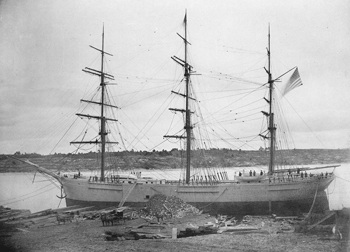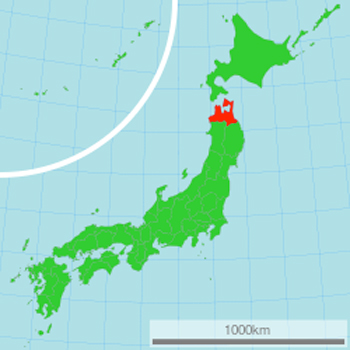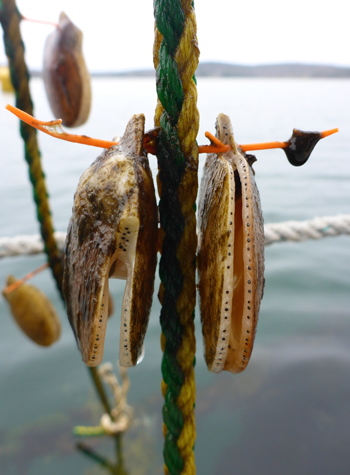The Cheseborough
A Tragedy That Cemented Goodwill Between Nations
by Tom Seymour

The 204' Cheseborough at a port in Washington state in the 1880s. It was built in Bath, Maine in 1878 for the Arthur Sewall Company of Bath. The waterline suggests it is between cargoes with what appear to be casual visitors aboard. Note two of them in the rigging. Photo courtesy of Maine Maritime Museum, Bath, Maine.
Built in Bath, Maine, by Arthur Sewall & Co., the full-rigged ship Cheseborough was launched in 1878. The now-famous, 204-foot vessel served her owners until October 30, 1889, when a typhoon caused her to founder and finally run aground one mile out to sea from the village of Shariki, Japan.
People in the village soon spied the tattered sails on the doomed ship and taking to small boats, headed out to rescue whomever they could find. Others tied ropes to themselves and with that, walked out into the sea to search for survivors. Others on land lit warming fires and brought food and fresh clothing for the scant handful of survivors.
While this was going on, cargo from the doomed vessel washed ashore, including onions, potatoes, canned fruit, personal items from the crew and even farm animals such as pigs. And since the ship was hauling sulphur, that, too, made its way into the sea, turning the water yellow. Such was the eerie scene that enveloped the area.
One item listed as being found by the villagers was a pear seed. This, however, seems implausible, since at a time of such turmoil and horror, no one would notice a lone seed. The more likely scenario is that the villagers saw a pear that had washed ashore, rather than just a seed. But there’s more to the story. The people took a seed from the pear and planted it in the backyard of Mr. Nakamura. The seed germinated and grew into a large pear tree and every year Mr. Nakamura offered pears from tree to the graves of the dead sailors from the Cheseborough. That tree still stands today, a reminder of the kindness and genuine care for humanity exhibited by the people of Shariki.
The rescuers had no idea where the ship or sailors hailed from and asked survivors, “Are you Napoleon?,” Are you Bismarck?,” Are you Washington?” In other words, they were asking if the shipwrecked sailors were from France, Germany or the U.S.A.
The villagers managed to rescue three sailors and at the same time, found a man from the ship washed ashore in a dying condition. One local woman, Mrs. Kudou held him against her bare body, inside her kimono, in order that her body heat might warm him and restore him to health. The effort was successful and the man lived. Despite the best efforts of the heroic villagers, 19 of the crew drowned.
Two young persons
ran 40 miles to the
prefectural capital
of Aomori.
The villagers nursed the four living sailors back to health, while two young persons ran 40 miles to the prefectural capital of Aomori to get help. The youths had nothing to sustain them except for some rice balls that they carried with them.
After the initial shock, the rescued crewmen stayed in local houses and villagers tended to their needs. People from miles around participated in this effort, bringing wool blankets, chickens, eggs and other foodstuffs to nurture the sailors. Upon returning home to America, the survivors and their families wrote to their saviors in Japan and this back-and-forth communication lasted for many years.
The people of Shariki continued to scan the beaches for the month following the disaster, finding numerous bodies and parts of the ship. The villagers then asked the prefectural office to turn the bodies over to them so that they could bury them with the respect they felt the dead sailors deserved.
Heartfelt Grief
In addition to supplying material needs for the survivors, the people of Shariki were moved to hold memorial services for those who had died in the wreck. Accordingly, both Buddhist and Shinto services were held. But this wasn’t a one-time event. The annual services have gone on in perpetuity, continuing through the dark years of World War II.
Today a granite monument stands watch over the beach where the Cheseborough and her crew met their fate. Displays at the monument detail the events of that tragic day in 1889. In addition, village children learn about the shipwreck and rescue. The event has become an important part of the village’s history.
The legend on the monument reads, “The people who disappeared into the rough seas. The people who survived. The people who rescued by doing their best. Now, there is no one left. Only the bleat of the gulls and the sound of the sea are the same as the past.”

Aomort Prectuure (red), Japan. The town of Shariki is on the west coast of Aomori.
Back in America, the kindness of the people of Shariki was fondly remembered and from 1889 on, the Village of Shariki, Japan, and the City of Bath, Maine, remained united in friendship. In 1990 a delegation of officials from Bath visited Shariki to further cement the bonds of friendship and culture-sharing. Following this, swim teams from Bath have traveled to Shariki to participate in the Cheseborough Cup International Swimming Competition. This is part of the annual Cheseborough Festival, which began one year after the Cheseborough sinking.
The swim competition takes place in a cove on the Sea of Japan. The ultimate goal, however, is much more far-reaching, that being to swim the equivalent of the10,200 kilometers between Shariki, Japan, and Bath, Maine.
Then in 1994, Shariki and Bath joined in a sister-city pact designed to ensure continuing cooperation and cultural exchange. Then-president of the United States, Bill Clinton, sent a letter to the people of Shariki, commending them for honoring the crewmen who “…lost their lives when the Cheseborough sank in 1890.” Somehow, the president got the date wrong, but the sentiment of his message was clear.
President Clinton praised the citizens of Shariki for hosting exchange students from Bath, Maine, and called the exchange program, “building blocks for stronger ties between Japan and the United States.”
The annual services
have gone on in
perpetuity, continuing
through the dark years
of World War II.
The exchange program, of course, works both ways and each year a group of Japanese students visit Bath, Maine. The trip is open to 8th grade students who have taken English in school.
The exchange program was so important to both Bath and Shariki people that despite the merger in 2006 of Shariki and four other villages into the new, Tsugaru City, the newly formed city chose to continue the program. Tsugaru City then sent a group of officials to Bath to re-sign the agreement so that it may continue unchanged.
Continuing Efforts
A March 16, 2016 article in Maine Today highlighted the visit to Portland by a group of Japanese artists for a residency program. The exhibition that followed included prints by artists from both Maine and Japan. According to the article, This was shortly after an exchange of prints that were displayed at the Aomori Municipal Art Pavilion in Japan. The visiting artists also worked with students from the Maine College of Art. The Maine Today article pointed out that this venture was a continuation of the close relationship between Maine and Japan that began when Japanese villagers rescued survivors of the stricken ship, Cheseborough, in 1889.
Shared Technology

An example of Japanese scallop raising techniques such as hanging scallops simply using holes drilled in the shells and a pin through the shells and rope. These techniques were observed by Maine scientists and aquaculturalists on trips to Aomori, Japan in 2012 and 2016. This photo was taken of the Japanese practices in Maine. Photo courtesy of Maine Sea Grant and UMaine Cooperative Extension.
In addition to sharing its culture through art, Japan has also begun sharing fish-farming technology with Maine. Specifically, Japan has long been a leader in commercial scallop farming, something Maine has only recently begun to embrace.
Since 1994, Maine and her Sister State of Aomori, Japan, have shared not only art and cultural topics, but also education and fish-harvesting practices. And in September of 2016, Maine aquaculture specialists visited Aomori, Japan, to better learn their scallop-farming techniques.
And now, according to an April 29, 2018 article by Bill Trotter in the Bangor Daily News, CEI, a business development group out of Brunswick, has received a $300,000 grant to explore the feasibility of raising scallops on ropes off the Maine coast. Already, two Maine companies, Bangs Island Mussels and Pine Point Oyster are using Japanese technology in the form of machines, which in Japan are used to reduce much of the drudgery involved in tending farm-raised scallops.
The groups are assessing the possibility of modifying the Japanese-made machinery to work with Maine scallops. Maine’s scallops are smaller than their Japanese counterparts and the shells are thinner and thus, more fragile.
Several different mechanical devices are used in the scallop-raising process. First, a machine sorts scallops according to size. Then another machine drills a hole into the hinge (connecting point for two shell halves) of each scallop. After this, workers must, by hand, push a plastic pin through each hole.
Next, the scallops are attached to a line. The scallops must be evenly spaced, since unlike other commercially raised shellfish, scallops need space around them in order to fully develop. After this, yet another mechanical device cleans the various forms of organic material that naturally adheres to the shells while in their marine environment.
If successful in modifying this Japanese technology to fit Maine’s needs, scallop farming may come online in Maine in a big way. While farmed scallops will never come even close to matching the sheer number of wild scallops taken off the Maine coast, they will add greatly to the overall numbers. Also, niche uses for farmed scallops will put them in a different category than their wild cousins.
So it is entirely possible that in the near future, Maine fishermen will have Japan to thank for this helping hand in gaining a working knowledge of scallop farming with the help of specially designed machinery. We can view this as just another part of the legacy of help, friendship and cooperation between Maine and Japan, a result of Japan’s kindness during the sinking of the Cheseborough.
And it all began when a Bath-built sailing vessel went aground near the (then) farming community of Shariki, Japan.
